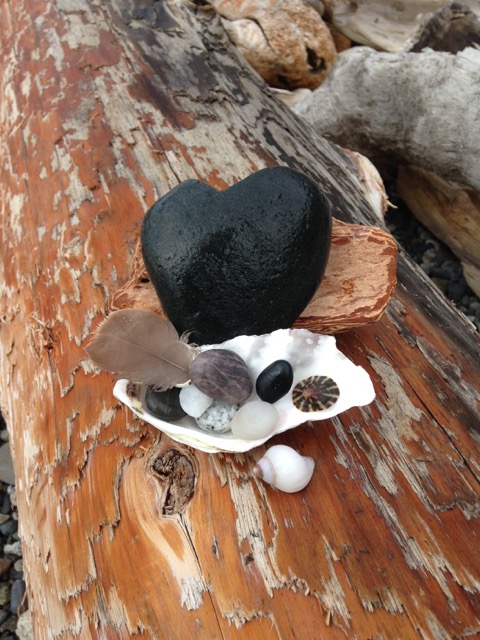Cardiology and Mindfulness: Taking care of the heart
When I was invited to talk at the Center for Spiritual Living in Hamilton, MT on the topic of global transformation through personal transformation my first thought was “Is there any other kind?”
Global transformation can really only happen at the level of the individual, and individual transformation can really only happen at the level of the heart. As a physician, meditation teacher and lifelong spiritual journeyer, I am interested in matters of the heart. Over the past 15 years I have done a lot of exploration, study and self study, training and teaching in the arena of wellness and wellbeing through the use of mindful attention. Mindfulness involves paying attention to what is happening in the present moment, as it is happening, in an open and nonjudgmental way. For me, this journey has involved a lot of being still, getting quiet, going on retreats, working with teachers, and listening deeply.
More recently, I have been studying for the internal medicine boards which is a very conventional kind of learning for a very conventional kind of exam. When I was invited to give this talk, I was in the midst of my cardiology module. I was reading, highlighting, taking notes and taking sample tests. At first I was struck by the contrast of these two different areas of study, but the more I thought about it, the more I came to see some interesting similarities and parallels. The are both ways of caring for the heart.
Mindfulness is really about the heart as much as it is about the mind. The Chinese ideogram for the word heart is the same as that for the word mind. In Eastern ideology, the heart and the mind are not separated. Therefore, mindfulness is can also be thought of as heartfulness.
So what can we learn from studying the heart by way of modern cardiology and how can mindfulness help us take care of our own heart?
The heart has its own intelligence. It has its own special internal pacemaker that knows when to beat and how fast. It responds to stress, hormones, exercise, grief and sleep. It responds to regular exercise and conditioning by setting a lower baseline pulse rate. When the heart is healthy, the natural pacemaker is flexible, dynamic and responsive. Of course this natural pacemaker can get off track. It can get blocked and beat too slowly. It can get overwhelmed by accessory conduction pathways and beat too fast. It can become chaotic and disorganized and loose control completely, beating randomly, and sometimes it can get so out of control that it takes a jolt of electricity in order to regain its underlying right rhythm.
There is an exciting moment in the world of cardiology when a person’s heart gets to beating too fast, in a particular kind of frenzy called supraventricular tachycardia. Usually a person with condition feels palpitations, chest pressure, anxiety, shortness of breath, and lightheadedness. Often they show up in the emergency room which is the right thing to do. When the patient is hooked up and the heart rate is seen on the monitor going 180 beats per minute, It makes everyone’s heart beat a little faster.
The medication of choice for this condition is injected into a vein while doctors and nurses stand watching the patient’s heart rhythm on the monitor. When the medicine reaches the heart, the rhythm suddenly stops and there is a complete pause. No heart beat. A flat line. Nothing happening. These moments can seem to last a very long time. Everyone is hyper-alert, fully present. What will happen next? Will the heart beat ever kick in again? …. And then it does, one beautiful beat comes tentatively across the monitor followed by another and then another. And then we all breathe a sigh of relief. The heart was jolted out of its chaos, took a pause, and its innately intelligent rhythm was able to take control again.
Sometimes our lives are like this. They get out of control and we lose our sense of internal right measure, our sense of balance, responsiveness and flexibility. Our modern lives are far too complex. We are juggling jobs, family, health issues, relationships, and financial stress. We are burdened by political stress and the grief of climate change. We are bombarded by electronics intended help us be more efficient and get more done. But the hidden injury in being constantly connected is that we are pretty much constantly overstimulated and distracted. We are in a state of continuous partial attention, scattered, scurrying, disorganized. In this state of mindless scatter, we are not our best selves, and it is hard to be in touch with our internal wisdom and balance.
Rather like the heart beating out of control, we have lost our internal pacemaker. We need a pause.
Sometimes a pause comes to us in the form of a cataclysmic event such as illness, injury, depression, or loss. Sometimes these are the kinds of things it takes for us to stop what we are doing and just be still, the proverbial wake up call. But it is also possible to avoid getting to the point of a systems break down by intentionally pausing and listening along the way.
We can pause in just about any moment of our life and notice a sense of being embodied. Even right now we can feel the the ground under our feet and the density of the body sitting in the chair, experience the sensation of the breath moving in and out, and feel the aliveness of this human body that we inhabit. We can pause and take in our surroundings, no matter what they are, pleasant or unpleasant, we can bring our attention and curiosity to each moment and notice the touch of air on the face, the warmth or coolness, the sounds being received by the ears and the effect of those sounds on the body/mind. Right in the middle of our everyday lives, we can pause to notice that we are alive. In this way, we can reclaim and rediscover the our innate wisdom and restore internal right measure.
However, since the mind is such a habitual thing, the ability to remember to pause and rest in awareness is best supported by a regular practice of some sort. I am an advocate of regular formal mindfulness practice because what we practice gets stronger: the way we are in this moment is highly predictive of the way we will be in the next moment. Building in a period of time each day to be still and notice is a powerful way of taking care of our heart. Cultivating the ability to listen deeply to ourselves allows our true wisdom and beauty to be known.
Rumi writes:
Sometimes you hear a voice through the door
calling you, as fish out of water
hear the waves, or a hunting falcon
hears the drum’s
Come back.
Come back.
This turning toward what you deeply love
saves you. Read the book of your life,
which has been given you.
A voice comes to your soul saying,
Lift your foot. Cross over.
Move into emptiness
of question and answer
and question.
—Rumi
The heart first pumps blood to itself. As freshly oxygenated blood is pumped out of the heart through the aortic valve, the first arteries to branch off the aorta are the coronary vessels, those that feed the heart muscle itself. The heart nourishes itself first to remain strong and healthy and able to sustain the rest of the body.
I think we can take great comfort in this wisdom in this design and also learn a very important lesson. Self care and self compassion are not selfish. They are necessary. In the eastern traditions, it is understood that compassion is not complete unless it includes one’s self.
Many of us are very comfortable taking care of others needs, putting others first, affording kindness, forgiveness, giving the benefit of the doubt to others. But we do not tend to give this same kind of treatment to ourselves. We are often our own harshest critic. While caring for and serving others is indeed very good medicine and very good for the heart, we also have to take an honest look at how we are treating ourselves, both physically with what we consume and how we live our lives and also spiritually and emotionally with our underlying self talk and inner critic that may be at work just under the surface in our own mind.
The practice of mindful self compassion can be a powerful and healing balm for the heart: offering to ourselves the same words of kindness that we would offer to a good friend who is suffering. Listening to our own heart and to our body is a gift in itself. How often do we just keep pushing ourselves forward, taking a pill to make the physical symptoms go away, or criticizing ourselves for not being able to do more? What we really need is some deep listening, a gentle touch and some caring words. Perhaps we can place a hand on our own heart and say “I care about this heart, or this pain or anxiety or grief etc”.
Carl Jung wrote:
That I feed the hungry,
forgive an insult,
and love my enemy…
these are great virtues!
But what if I should discover
that the poorest of the beggars
and the most impudent of offenders
are all within me,
and that I stand in need of the alms of my own kindness; that I myself am the enemy who must be loved?
What then?
The heart gets blockages. Despite our best intentions, this is true both physically and spiritually. The coronary arteries gradually build up plaque from our less than perfect diets, stress, smoking, and other medical conditions that comprise risk factors for atherosclerosis. The body then deposits calcium in this plaque resulting in what we have come to call it hardening of the arteries. I find this to be a very appropriate term. In a figurative sense, our hearts can also gradually become hardened through our life’s journey from the various hurts, disappointments, self doubt and sense of unworthiness that we acquire along the way. Most of this is layered on thicker and thicker by our thinking, ruminating minds.
In fact, if we look at what the mind is up to most of the time, we may see that much of the content of the mind is negative. This is not our fault, nor is it a character flaw. The mind comes equipped with a negativity bias in an effort to protect us. Studies show that the mind is much more likely to retain and remember negative, distasteful and threatening memories than it is to retain peaceful, neutral or pleasant material. This adaptive and protective aspect of the mind can color our perception of the world and have negative effects on our health and physiology. Though most of us would say we do not enjoy these difficult thoughts and emotions, we practice anger, we rehearse resentment and we cultivate outrage in effect, watering the seeds of negativity that steadily harden the heart. These negative thoughts tend to harden our hearts and block the flow of love to ourselves and others. And the truth is, most of this goes on just far enough below the surface that we are not aware of it.
Mindfulness practice can help us see the content and workings of the mind more clearly, and once we have seen more clearly we can make a different choice. In this very moment, we have an opportunity, and even a responsibility, to search for what is blocking the heart and do what we can to soften and open: to choose patience over anger, curiosity over outrage, forgiveness over resentment. In a very real sense, this is our life’s most important work, to learn how to live with an open heart.
Your task is not to seek for love,
but merely to seek and find all the
barriers within yourself that you have
built against it.
~Rumi
I’d like to close by offering a metta prayer for us all.
The ancient practice of metta, or loving kindness, was taught by the Buddha to his disciples as a way of opening and transfiguring the heart in difficult circumstances. The story goes that the Buddha sent his monks into the forest to meditate, but there they were confronted with terrifying images and what seemed to be evil spirits. They came back to the Buddha saying they could not possibly practice meditation in that environment. It was then that the Buddha gave them the practice of metta, and sent them back into the forest to practice it. The first step of the practice of metta is to send loving kindness to our self to gradually soften and transfigure our own heart. Then, we can intentionally widen the circle to include others. One of the beauties of the metta practice is that it is already complete when we practice for ourself. Its transformative power is so great that it will not be limited to ourself alone. It will naturally extend beyond the self to those around us.
Closing the eyes if you are comfortable with it and sensing into the body exactly as it is.
Feeling the sensation of the breath moving in and out of the body.
Placing a hand over your heart if you want to and offering yourself these wishes:
May I be safe and protected from inner and outer harm
May I be healthy and know that I am already whole
May I be happy and content
May I be peaceful and be an instrument of peace in this world
Rainbow over Missoula







